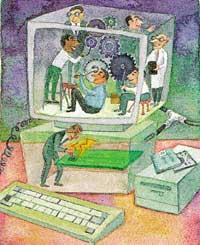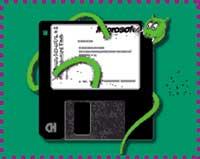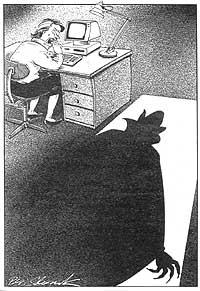I love you, famous computer viruses
2000/06/11 Kortabarria Olabarria, Beñardo - Elhuyar Zientzia
The network of networks, the Internet, has changed the world. The electronic market is already a reality. Contracts, business, purchases and sales, information shipments, etc. can and are done through the Internet. The network that is becoming a basic network for today's society has broken borders, but at the same time it is an ideal road for computer viruses, wide and comfortable.

According to computer security experts, the biggest problem for both companies and people working with computers is computer viruses, which avoid time and destroy many resources. According to the International Association of Computer Security, last year, at least 99 out of 100 companies have suffered a virus attack that five years ago did not reach 25. At the same time, viruses have multiplied: 5 years ago about 5,000 were known, while currently it is estimated that there are about 40,000 and every month about 300 news is generated. They say they are causing more and more damage. According to a study conducted in the United States, during the first six months of last year the viruses caused a loss of 1.2 billion pesetas in companies. 5 times more than in 1998.
But what are computer viruses?
Virus is a computer program with the ability to spread and reproduce the main program. It remains hidden until it is released and at that time causes damage, problems or discomfort on the computer. How are the damage?

The effect of some viruses is limited to creating annoyances, they can make appear messages on the computer screen, start animations, sound…, more than damage, hinder. The ambulance that suddenly appears on the screen, the sporadically exiting ping-pong ball, or the Brain virus, Cookie, can be an example of this. There are also viruses that only cause small damage and do not go through data loss. In most cases, these viruses are easily recognizable and, if a suitable tool is available, it is not difficult to retrieve lost information. The Jerusalem virus, which removes documents used between Friday and 13, is an example of this. This damage classification now includes viruses that cause major damage: data loss, formatting hard drives and floppy disks, etc. If you have backups, there are no problems repairing the damage caused, if no backup is over! Andrew, Azusa, Barrotes, DarkElf are viruses. Finally, there are viruses that cause very serious damage. These can be grouped into two groups. On the one hand, the user does not realize that there are viruses that slowly damage the computer. They are very serious, as these backups also store errors caused by the virus, so it is necessary to go back a lot in time to find incorrect copies. On the other hand, there are viruses that act on the boot system of the computer, not only format the hard drive but do not allow the boot of the computer. Chernobyl and Emperor viruses can be an example of this.
Although the history of the first viruses is 50 years ago, the first viruses, that is, programs that are capable of proliferating and contaminating other programs, computers or disks, are 15 years ago. When contaminated with diskette they did not spread excessively. The network's first virus spread on November 2, 1988, when the network now called the Internet was used exclusively by military personnel. Using email, this virus slowed the operation of many computers for three hours. Afterwards, the Internet network has grown a lot and with the Internet the virus festival has arrived: there are more viruses, they use many systems of concealment, they have added the speed of the infection, there are viruses capable of combining the systems of infection and the authors have a promising future, since in addition to having access to tools to make viruses, also a way of diffusion. Although they use other ways, email is the most normal way viruses use.
Therefore, as for computer viruses, it is observed that the future is full of threats. Faced with this new reality, most companies simply give solutions to specific problems, without thinking that the key can be in prevention.

However, as viruses have multiplied and become more dangerous, the tools to combat them have also grown. To spread them they use the Internet and antivirus systems work the same way. Currently there are antivirus that are renewed daily to combat viruses, capable of generating vaccines in a few hours before new threats. In the Basque Country there is a computer company dedicated to it: Panda Software. The Bilbao company focuses on both aspects, both in the prevention of viruses and in the repair of the damage caused by them.
As for the fight against viruses in computers, this company, founded 10 years ago, is the leading and third in the world in Europe. Panda is a pioneer in the use of the internet to combat viruses. Panda technicians look for new viruses on the Internet day and night. Panda has developed its software and offers protection service 24 hours a day. Every day, through the Internet, you can check your computer and also every day automatically enter vaccines against new viruses into your computer.
But who creates viruses?
Why? These are difficult to answer questions. On more than one occasion they have been answered that they were people without conscience, marginal young people, people without social life… but it seems that the reality is very different. According to the studies carried out, the authors of viruses are normal people, with a great knowledge of computer science and also consider that what they do is not bad. Although they don't believe it, at least they do.
Published in 7

Gai honi buruzko eduki gehiago
Elhuyarrek garatutako teknologia




